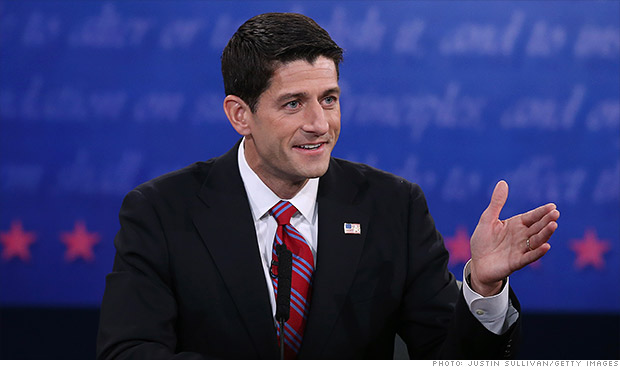
Paul Ryan's budget proposal hits Republican high notes: lower spending, lower tax rates and a rejection of most of President Obama's health reforms.
NEW YORK (CNNMoney)
The plan, which contains many of the same provisions he offered last year, hits all the GOP high notes: less spending, lower tax rates and a rejection of most of President Obama's health reforms.
Ryan's proposal represents the start of a months-long process on Capitol Hill aimed at enacting a budget for the 2014 fiscal year, which begins in October.
On Wednesday, Democratic Senate Budget Chairman Patty Murray will put out her own 2014 proposal that is expected to contrast sharply with Ryan's.
But the two sides are likely to view each other's budget proposal as dead on arrival.
While Democrats and Republicans have called a truce in their fight over this year's budget, vowing to work to avoid a government shutdown later this month, but they remain sharply divided over broad fiscal policy for 2014 and beyond.
Still, their plans set the boundaries as lawmakers try to negotiate some kind of middle ground.
Here are the main provisions of Ryan's budget proposal.
BALANCED BUDGET
Ryan's proposal doesn't detail all of the assumptions he makes about certain variables like economic growth or when some of his proposals would go into effect. So it's hard to know exactly how he so quickly and steeply cuts deficits.
But lower spending and a revenue windfall from the fiscal cliff deal brokered over New Year's are key drivers.
His plan would leave the country's accrued debt at just under 55% of gross domestic product by the end of the decade, according to Ryan's estimates. That's well below the 77% projected by the Congressional Budget Office under current law.
It should be noted that CBO won't analyze Ryan's -- or Murray's -- budget resolution since each simply proposes targets for taxes and spending and does not detail legislative changes for hitting those targets.
SPENDING
Broad reductions: Ryan estimates that his proposals will grow spending at an average rate of 3.4% a year, rather than the 5% projected.
In 2014, his plan calls for $3.53 trillion in spending -- a little less than the $3.62 trillion projected by the CBO
By 2023, however, spending under the Ryan plan would fall about $985 billion below the level the CBO has projected for that year.
He would cut spending in several ways. For instance, he extends the lower caps on discretionary spending set by the 2011 Budget Control Act for two more years. So instead of applying them just through 2021, as the law calls for, they would extend through 2023.
Reform Medicare, preserve cuts: As Ryan did last year, he is proposing the creation of a Medicare premium support system starting in 2024. That means those 55 and older would not be affected.
Future seniors could choose between traditional fee-for-service Medicare and the premium support system, which would offer them a fixed amount of money to buy private health insurance.
Related: The real Medicare spending problem
The premium support payment would grow at a rate equal to economic growth plus 0.5 percentage points.
Such a system would limit federal spending on Medicare, whereas today there is no cap on what the government pays.
Ryan also wants to repeal major elements of Obama's health reform law including subsidies for Americans who buy their insurance on newly created exchanges. He told Fox News on Sunday that he would preserve the law's spending cuts to Medicare, but instead use those savings for deficit reduction rather than to fund insurance subsidies.
Medicaid block grants: Ryan again proposes converting federal Medicaid funding for states into block grants and repealing the health reform law's expansion of the program to low-income, nonelderly adults.
Currently, spending on Medicaid is variable because of fluctuations in enrollment.
Block grants could increase the burden on states, but also give them more autonomy about how to set up their Medicaid programs. For example, a state could reduce how many people are eligible or increase enrollees' cost-sharing obligations.
Food stamp block grants: Ryan would also convert funding for food stamps to block grants to states and change the terms of eligibility by imposing time limits on participation and work requirements.
Currently, federal spending on food stamps varies because enrollment fluctuates.
Require federal workers to contribute more to savings: Federal civilian employees under Ryan's plan would have to contribute more money toward their retirement pension plans.
TAXES
Matches the CBO on revenue: Ryan's budget would raise the same amount of revenue as projected by the CBO. Over 10 years, revenue would total $40.241 trillion.
Despite Republicans' lambasting of health reform for the taxes it raises to pay for insurance subsidies, Ryan's budget doesn't appear to explicitly repeal them.
Annual revenue would average 18.8% of GDP, slightly more than the 18.3% average over 40 years. In some years, revenue would go as high as 19.1%.
Reform the tax code: The Ryan budget calls on Congress to complete major tax reform by 2014.
Fellow Republican Dave Camp, chairman of the House Ways and Means Committee, in a letter last week itemized GOP priorities: simplify the tax code; reduce the number of individual income tax rates to two (10% and 25%); repeal the Alternative Minimum Tax; lower the top corporate tax rate to 25%; and change the rules for international taxation.
And, Camp added, "the committee will continue to oppose any and all efforts to increase tax revenues by any means other than economic growth."
- CNN's Deirdre Walsh contributed to this report. ![]()
First Published: March 12, 2013: 10:01 AM ET
Anda sedang membaca artikel tentang
What's in Paul Ryan's budget
Dengan url
http://kasiatbuatsehat.blogspot.com/2013/03/whats-in-paul-ryans-budget.html
Anda boleh menyebar luaskannya atau mengcopy paste-nya
What's in Paul Ryan's budget
namun jangan lupa untuk meletakkan link
sebagai sumbernya


0 komentar:
Posting Komentar